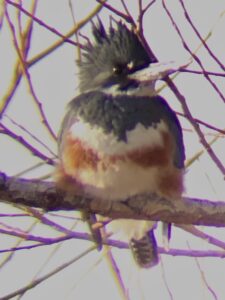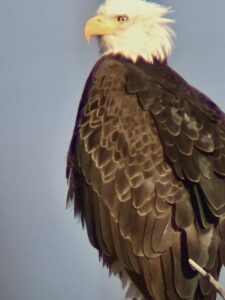The cold front that moved in on Thursday did not disappoint, as the morning of the 11th of December proved to be a frigid one. The thermometer was at 28° at 8:00 a.m. and a cold breeze was blowing from the west. 8 birders arrived at Teller Farm bright and early, ready to meet the birds that find a winter home in the White Rocks area.
From the Teller Farm parking lot, we headed north across Valmont Road towards White Rocks. The first portion of the trail followed the path of Dry Creek. The thickets of willows and cottonwoods that grow along the creek cut a meandering path through agricultural fields. The first memorable bird of the walk was a Red-tailed Hawk perched on the edge of the field north of the creek. The hawk gave us some good looks through the scope and then took off across the field. While the hawk was perched, a female Belted Kingfisher flew to a perching spot above the creek. As she sat there, a mixed flock of American Goldfinches and sparrows moved through the willows. We could barely catch a glimpse of them as they flew about before descending deeper into the thicket, but their calls alerted us to their continued presence.
When I find riparian corridors such as this, I like to reflect on what this area looks like from a bird’s perspective. To us, the dirt path that we walk down is what we perceive this area to be. We need clear, open land to walk through, for our size and shape limits our movement through dense brush. For small passerines like the Song Sparrow or American Goldfinch, these densely vegetated creeks provide much needed shelter in an otherwise inhospitable environment. To them, the vast open spaces that we desire are full of many dangers. The lack of cover exposes them to predators and the harsh elements, along with sparse foraging opportunities to be found. To our smaller avian friends, these riparian corridors are their trails through a world filled with many dangers.
While some bird species prefer these thickets, others find their domain in the vast open sky. As we continued to head north towards the ponds, we spied two of these lords of the air. The mated Bald Eagle pair that has nested in this area were perched far off to the west of the ponds. As we admired them from a distance, they suddenly took off from their perch, seemingly dancing through the air as they flew eastwards towards another perching spot even closer to the trail. We were able to walk very close to one of them, standing on the bridge right underneath the cottonwood where it was perched. They permitted our presence for a good while, and then with a lordly glance down at us that almost seemed to remind us that this was their domain, they took off to the sky.
After the eagle, the cold seemed to be getting to the group and we were ready to turn around. Before we did that, we walked a little farther down the trail to a point where it started to rise up a hill. This section is made up of shortgrass prairie habitat, with a couple of acres of prairie dog town to the northwest of the trail. Sitting on the ground amongst the prairie dogs was a juvenile Ferruginous Hawk, a habit that is characteristic of this largest of North American hawk species. I had seen this particular bird multiple times in this prairie dog town, a sign that this area and its rodent populations are important for many different raptor species.
While we admired the hawk and a flock of Western Meadowlarks perched high in a willow, a flash of black and white flew across the landscape. I followed it to where it perched atop some bushes, and from there we got our first looks at a Northern Shrike. This predatory songbird winters in Boulder County and it was a first for many on our walk. We were able to get some brief looks at them through the scope, but these birds seem to be quite energetic and rarely sat still for more than a minute. We chased them through our optics from perch to perch until they flew out of sight, off to find some songbird or rodent prey. Their habit of storing their food for later by impaling them on thorns and barbed wire has earned them the gruesome nickname of “butcherbirds.”
After the Shrike took off, we spotted another unique bird that winters in this area. Far off to the west of the trail, a Harlan’s Hawk was perched high up in a cottonwood. The Harlan’s is a subspecies of the Red-tailed Hawk and this particular bird has spotted here fairly frequently over the past month. They nest in central Alaska and then make their way down the eastern slopes of the Rocky Mountains to winter on the central Great Plains. They make up a small percentage of the greater Red-tailed Hawk species and can be difficult to identify, with dark, intermediate, and light morphs of their own, along with interbreeding with other subspecies of Red-tailed Hawks.
Even though we had already seen some of our target species, we were not done with more wildlife sightings. As we scanned across the prairie dog town, we became aware of their calls becoming more agitated. Sure enough, the culprit was the ubiquitous prairie wolf, also known as the coyote. It appeared to be attempting to make its way through the town, with occasional glances back at us. Its path was made a little difficult, however, by a Northern Harrier that didn’t take too kindly to its presence. The Harrier dive-bombed the coyote a few times before finally letting it pass through. Once the coyote moved on and the Harrier had enough, we decided we had had enough of the cold as well and started walking back.
The walk back brought us glimpses at the more common species of this area. A Great Blue Heron flew overhead, while a mixed flock of Canada and Cackling Geese attempted to find comfort on the frozen pond. It was also filled with each of us recounting our favorite experiences of the day and sharing what we had learned. The camaraderie that develops on bird walks is one of my favorite things about birding in groups. Everyone has something insightful to share and I usually walk away learning something new, from both novice and expert alike. It is especially enjoyable to bird together in the winter months, when the cold weather and dark days can make life seem a little tougher. With a group of enthusiastic birders and the birds to help us through the cold, brighter days don’t seem that far away.




Comments
Write Comment